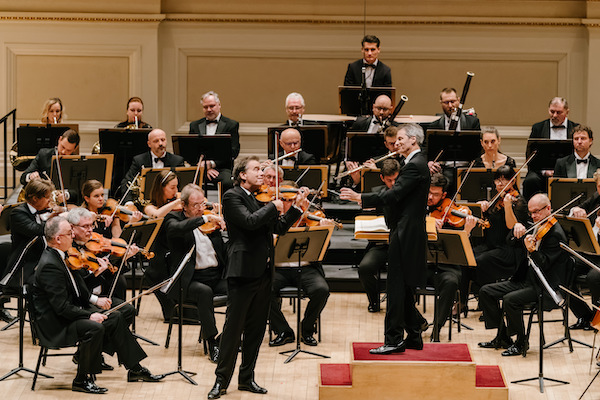A versatile Czech orchestra shows itself at home in Carnegie Hall

The Czech National Symphony Orchestra may be best known internationally from the movies.
The ensemble records numerous film scores and had an important association with Ennio Morricone, playing his European tours and recording his score for The Hateful Eight. The ensemble also frequently backs singers from the classical, pop, and crossover worlds.
In Carnegie Hall Thursday night, the CNSO showed another facet of what it can do with the mainstream classical repertoire. With Steven Mercurio at the podium, the orchestra played Dvořák (the Finale from his Op. 39 Czech Suite), then Brahms’ Violin Concerto, with Robert McDuffie and after intermission Beethoven’s Symphony No. 3. The impressive experience showed this as a fine orchestra that may make a living in the pop worlds, but also delivers the goods in some of the most famous, and important, works in classical music.
The first impression came through size and sound: the CNSO is smaller than most modern orchestras, a midsize group with lighter textures. As one heard in the fleet, charming Dvořák selection, it has a regional sound, with earthy colors in the woodwind section, especially an exceptionally woodsy oboe quality, in itself a real, and infrequently heard, pleasure.
One also rarely hears the Brahms Violin Concerto with this lighter sound, and even rarer was McDuffie’s tremendously willful and invigorating performance. The default modern approach to Brahms’ orchestral music is a pillowy comfort with maybe a little lip service to some of the knottier expressions. The orchestral playing was sensitive and responsive to McDuffie, who pressed both the beauty and thorniness of the music to extreme degrees.
The violinist played with great expressive freedom that came from a place of deep thinking. He alternately teased and tore through his lines. The grace and delicacy were there, but also real sensations of darker passions and fierceness.
His passion was constant. McDuffie didn’t use rubato so much as he would take a moment before the start of a phrase to wind up, and then pour his ideas through the music. At one moment of intensity in the first movement, he let out an audible “ah!” before ripping through a line. Vibrato was less important than his tone, which modulated between sweet and burning acid.
The intensity of the first movement was through the roof; not only did the audience spontaneously applaud after it, so did some of the musicians in the orchestra. The Adagio was tender and without sentimentality. With this smaller group of musicians, the finale was far brighter, more light-footed, and even expressively appropriate than one usually hears. This was the kind of musicality and personal imagination that the classical world needs more of.
After intermission, the performance of the “Eroica” was straightforward and excellent. Again, this lighter sound flattered the music (although the trumpets were at times overbalanced). Mercurio’s tempos all felt just right, and the way he followed the large-scale shape of each movement was ideal; everything built both short-term and long-term tension and release, the fundamental in Beethoven.
The players were in tune with this, the thrill of the music building up through them as they rode the valleys and peaks, pressing the intensity in the greatest moments of crisis in the first two movements, and in the quiet building of tension in the coda of the finale.
Mercurio acknowledged the ovation that followed with two brief encores that got at the orchestra’s bread and butter: a bit of chase-scene style music from commercial composer Logan Jones, and then Morricone’s ravishing “Gabriel’s Oboe” from his score to The Mission. One left admiring the range and quality of this lesser-known orchestra.